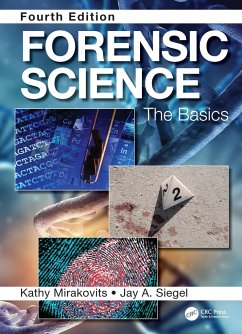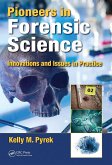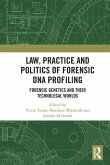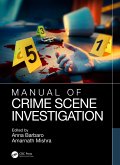Kathy Mirakovits (USA Portage Northern High School), Jay A Siegel (USA Michigan State University)
Forensic Science
The Basics, Fourth Edition
Kathy Mirakovits (USA Portage Northern High School), Jay A Siegel (USA Michigan State University)
Forensic Science
The Basics, Fourth Edition
- Gebundenes Buch
- Merkliste
- Auf die Merkliste
- Bewerten Bewerten
- Teilen
- Produkt teilen
- Produkterinnerung
- Produkterinnerung
Forensic Science, 4e follows in the tradition of the best-selling prior editions serving as a comprehensive introductory text presenting fundamental concepts in forensic science with new sections on forensic palynology & taphonomy, a new chapter on forensic psychology, and case studies throughout.
Andere Kunden interessierten sich auch für
![Critical Forensic Studies Critical Forensic Studies]() Roberta JulianCritical Forensic Studies40,99 €
Roberta JulianCritical Forensic Studies40,99 €![Forensic DNA Trace Evidence Interpretation Forensic DNA Trace Evidence Interpretation]() Duncan Taylor (Forensic Science South Australia (FSSA) Australia )Forensic DNA Trace Evidence Interpretation108,99 €
Duncan Taylor (Forensic Science South Australia (FSSA) Australia )Forensic DNA Trace Evidence Interpretation108,99 €![Forensic DNA Applications Forensic DNA Applications]() Forensic DNA Applications88,99 €
Forensic DNA Applications88,99 €![Fisher's Techniques of Crime Scene Investigation First International Edition Fisher's Techniques of Crime Scene Investigation First International Edition]() William J. TilstoneFisher's Techniques of Crime Scene Investigation First International Edition254,99 €
William J. TilstoneFisher's Techniques of Crime Scene Investigation First International Edition254,99 €![Pioneers in Forensic Science Pioneers in Forensic Science]() Kelly M. PyrekPioneers in Forensic Science47,99 €
Kelly M. PyrekPioneers in Forensic Science47,99 €![Law, Practice and Politics of Forensic DNA Profiling Law, Practice and Politics of Forensic DNA Profiling]() Law, Practice and Politics of Forensic DNA Profiling40,99 €
Law, Practice and Politics of Forensic DNA Profiling40,99 €![Manual of Crime Scene Investigation Manual of Crime Scene Investigation]() Manual of Crime Scene Investigation105,99 €
Manual of Crime Scene Investigation105,99 €-
-
-
Forensic Science, 4e follows in the tradition of the best-selling prior editions serving as a comprehensive introductory text presenting fundamental concepts in forensic science with new sections on forensic palynology & taphonomy, a new chapter on forensic psychology, and case studies throughout.
Hinweis: Dieser Artikel kann nur an eine deutsche Lieferadresse ausgeliefert werden.
Hinweis: Dieser Artikel kann nur an eine deutsche Lieferadresse ausgeliefert werden.
Produktdetails
- Produktdetails
- Verlag: Taylor & Francis Ltd
- 4 ed
- Seitenzahl: 714
- Erscheinungstermin: 6. Juli 2021
- Englisch
- Abmessung: 282mm x 218mm x 43mm
- Gewicht: 2134g
- ISBN-13: 9780367251499
- ISBN-10: 0367251493
- Artikelnr.: 62228382
- Herstellerkennzeichnung
- Libri GmbH
- Europaallee 1
- 36244 Bad Hersfeld
- gpsr@libri.de
- Verlag: Taylor & Francis Ltd
- 4 ed
- Seitenzahl: 714
- Erscheinungstermin: 6. Juli 2021
- Englisch
- Abmessung: 282mm x 218mm x 43mm
- Gewicht: 2134g
- ISBN-13: 9780367251499
- ISBN-10: 0367251493
- Artikelnr.: 62228382
- Herstellerkennzeichnung
- Libri GmbH
- Europaallee 1
- 36244 Bad Hersfeld
- gpsr@libri.de
Kathy Mirakovits is currently the principle of Forensic Science Education Consulting, LLC, a training resource providing workshops across the United States for teachers who wish to learn the application of forensic science in a school curriculum. She is a now-retired teacher to taught forensic science and physics at Portage Northern High School in Portage, Michigan, and physics at Kalamazoo Valley Community College in Michigan. She holds an MS in science education from Western Michigan University. She taught general science, physical science, chemistry, biology, earth science, and physics at the high school and two-year college level for more than 25 years. She also conducts. She has developed numerous forensic science educational products and has led workshops at the National Science Teachers Association. Kathy has served as president of the Michigan Chapter of the American Association of Physics Teachers and as a curriculum writer for the Michigan Department of Education. She was previously the high school director for the Michigan Science Teachers Association. She received the RadioShack Science Teaching Award and was a state finalist for the Presidential Award for Excellence in Math and Science Teaching. Jay A. Siegel (Deceased) held a PhD in analytical chemistry from The George Washington University and received its Distinguished Faculty Scholar award in 2009. He worked as a forensic chemist with the Virginia Bureau of Forensic Sciences for three years before spending 25 years as a professor and director of the forensic science program in the School of Criminal Justice at Michigan State University. In 2003 he went to Indiana University-Purdue University as founder and director of the forensic and investigative sciences program in the School of Science. In 2008 he was named the chair of the Department of Chemistry and Chemical Biology. He retired in 2012 and, sadly, passed away in September 2017 at the age of 71. Dr. Siegel was the co-editor of Forensic Science Policy and Management: An International Journal and Encyclopedia of Forensic Sciences, Second Edition, the co-author of Fundamentals of Forensic Science, and the author of Forensic Science: A Beginner's Guide. He testified over 200 times in federal and military courts, and was named distinguished fellow of the American Academy of Forensic Sciences in 2009.
Contents
Preface
Authors
Contributors
PART I: Forensic Science and Investigation
Chapter 1: Introduction to Forensic Science
Learning Objectives
Mini Glossary
Acronyms
Introduction
What Is Forensic Science?
History and Development of Forensic Science
What Is a Forensic Scientist?
The United States Forensic Science System
Other Forensic Science Systems
The Organization of Forensic Science Laboratories
Examination of the Forensic Sciences by Outside Organizations
After the National Research Council's NAS Report
Scientific Working Groups Reform and Support Quality Assurance
Summary
Test Yourself
Further Reading
On the Web
Chapter 2: Crime Scene Investigation
Learning Objectives
Mini Glossary
Acronyms
Introduction
Crime Scene as Recent History
Crime Scene Investigation Process
Summary
Test Yourself
Further Reading
On the Web
Case Study
Chapter 3: Nature of Evidence
Learning Objectives
Mini Glossary
Acronyms
Introduction
Classification of Evidence
Positive and Negative Controls
Summary
Test Yourself
Further Reading
On the Web
Case Study
PART II: Tools of the Trade
Chapter 4: Separating Complex Mixtures
Learning Objectives
Mini Glossary
Acronyms
Introduction
Physical Separation of Mixtures
Solid-Phase Extractions
Chromatography
Summary
Test Yourself
Further Reading
On the Web
Chapter 5: Light and Matter
Learning Objectives
Mini Glossary
Acronyms
Introduction
What Is Light?
Light as a Wave: The Electromagnetic Spectrum
Properties of Waves
Energy of Light: The Photon
Interactions of Light Energy and Matter
Spectrophotometer
Ultraviolet/Visible Spectrophotometry
Infrared Spectrophotometry
Mass Spectrometry
Summary
Test Yourself
Further Reading
On The Web
Chapter 6: Microscopy
Learning Objectives
Mini Glossary
Acronyms
Introduction
Lens: How Objects Are Magnified
Compound Microscope
Modifications of the Compound Microscope
Electron Microscopy
Summary
Test Yourself
Further Reading
On the Web
Chapter 7: Detector Dogs as Forensic Tools
Susan Stejskal
Learning Objectives
Mini Glossary
Acronyms
Introduction
Scenarios
Forensic Tool: Canine Olfaction
Back to the Cases
Utility in Forensics
Summary
Test Yourself
References
On the Web
Chapter 8: Digital Evidence, Computer Forensics, and Investigation
Learning Objectives
Mini Glossary
Acronyms
Introduction
Challenges
Physical versus Virtual Crimes
Computer Crime
Criminal Law
Computer Crime Investigation
Wireless and Handheld Devices
Digital Cell Phone and Handheld Investigation
Computer Forensics
Legal Proceedings
Summary
Test Yourself
Further Reading
On the Web
Case Studies
Chapter 9: Forensic Engineering
Learning Objectives
Mini Glossary
Acronyms
Introduction
Engineering Profession
Forensic Engineer
Forensic Engineering Case Studies
Accident Reconstruction
Summary
Test Yourself
Further Reading
On the Web
Case Study
PART III: Patterns and Impressions
Chapter 10: Fingerprints and Other Impressions
Learning Objectives
Mini Glossary
Acronyms
Introduction: A Note on Pattern Evidence
Quest for a Reliable Method of Personal Identification
Origin of Fingerprints
Anatomy of Fingerprints
Detection and Visualization of Fingerprints
Comparison of Fingerprints
Comparison of Single Fingerprints
Automated Fingerprint Identification Systems (AFIS and IAFIS)
Common Questions about Fingerprints
Other Impressions: Footwear and Tire Treads
Summary
Test Yourself
Further Reading
On the Web
Case Studies
Chapter 11: Questioned Documents
Learning Objectives
Mini Glossary
Acronyms
Introduction
What Is a Questioned Document?
Questioned Document Examiner
Handwriting Analysis
Erasures, Obliterations, and Alterations
Typewriters, Photocopiers, and Computer Printers
Paper Examination
Ink Examinations
Physical Matches on Torn Paper
Summary
Test Yourself
Further Reading
On the Web
Case Studies
Chapter 12: Firearms and Toolmarks
Learning Objectives
Mini Glossary
Acronyms
Introduction
Firearms Identification
Anatomy of a Live Round (Cartridge)
Examination of Firearms Evidence
Digital Imaging Systems for Ammunition
Distance-of-Fire Determinations
Toolmarks
Summary
Test Yourself
Further Reading
On the Web
Case Studies
PART IV: Forensic Biology
Chapter 13: Forensic Pathology
Learning Objectives
Mini Glossary
Acronyms
Introduction
How to Become a Forensic Pathologist
Investigation of Death: Coroners and Medical Examiners
Death Investigation Process
Postmortem Interval: Time of Death
Exhumations
Teamwork Approach
Summary
Test Yourself
Further Reading
On the Web
Case Study
Chapter 14: Anthropology and Odontology
Learning Objectives
Mini Glossary
Acronyms
Introduction
Human Skeleton
Identification of Skeletal Remains
Individualization of Human Bone
Collection of Bones
Forensic Odontology
Summary
Test It Yourself 1: Pelvic Bones and Age
Test It Yourself 2: Bite Marks
Test Yourself
Further Reading
Helpful Websites
Case Studies
Chapter 15: Forensic Palynology & Entomology
Learning Objectives
Mini Glossary
Acronyms
Introduction
Forensic Palynology: Pollen and Spores as Evidence
Becoming a Forensic Entomologist
PMI: The Life Cycle of the Blowfly
Decomposition of a Body after Death
Factors that Affect PMI
Entomological Investigation and Evidence Collection
Summary
Test Yourself
Further Reading
On the Web
Case Studies
Chapter 16: Serology
Learning Objectives
Mini Glossary
Acronyms
Introduction
Blood
Analysis of Blood
Other Biological Fluids and Stains
Bloodstain Pattern Analysis
Summary
Appendix A: Trigonometry Calculation for Locating a Bloodstain
Try it Yourself: The Genetics of Blood Typing
Test Yourself
Further Reading
Useful Websites
Case Study
Chapter 17: DNA Typing
Learning Objectives
Mini Glossary
Acronyms
Introduction
What Is DNA?
Collection and Preservation of DNA Evidence
History of DNA Typing
Current Method of DNA Typing: STRs
Mitochondrial DNA
CODIS
Summary
Test Yourself
Further Reading
On the Web
Case Studies
Chapter 18: Hair
Learning Objectives
Mini Glossary
Acronyms
Introduction
What Is Hair?
Hair Growth
Hair Color
Structure of Human Hair
Human versus Nonhuman Hairs
Hair Treatment and Damage
Comparison of Human Hairs
What Can Be Determined from the Structure of Hair?
DNA Analysis of Hair
Hair as a Source of Drugs
Summary
Test Yourself
Further Reading
On the Web
Case Study
PART V: Forensic Chemistry
Chapter 19: Illicit Drugs
Learning Objectives
Mini Glossary
Acronyms
Introduction
Illicit Drugs
Control of Illicit Drugs in the United States
Analysis of Illicit Drugs
Summary
Test Yourself
Further Reading
On the Web
Case Study
Chapter 20: Forensic Toxicology
Learning Objectives
Mini Glossary
Acronyms
Introduction
Forensic Toxicology
Becoming a Forensic Toxicologist
Principles of Pharmacology
Pharmacology and Toxicology of Ethyl Alcohol
Absorption of Ethanol
Drunk Driving Laws
Field Sobriety Testing
Measurement of BAC
Driving Under the Influence of Drugs
Summary
Test Yourself
Further Reading
On the Web
Case Study
Chapter 21: Fibers, Paints, and Other Polymers
Learning Objectives
Mini Glossary
Acronyms
Introduction
What Is a Polymer?
Textile Fibers
Types of Fibers
Fiber Morphology
Analysis of Synthetic Fibers
Chemical Analysis of Fibers
Interpretation of Fiber Evidence
Paints and Other Coatings
Types of Paint
How Cars Are Painted
Collection of Paint Evidence
Analysis of Paint
Evidentiary Value of Paint
Summary
Test Yourself
Further Reading
On the Web
Case Studies
Chapter 22: Glass and Soil
Learning Objectives
Mini Glossary
Acronym
Introduction
Glass
Glass as Forensic Evidence
Soil
Summary
Test Yourself
Further Reading
On the Web
Case Studies
Chapter 23: Fires and Explosions
Learning Objectives
Mini Glossary
Acronyms
Introduction
What Is a Fire?
Extinguishing a Fire
Incendiary Fires
Investigation of a Fire
Role of Accelerants
Analysis of Fire Scene Evidence
Analysis of Accelerants
Explosions
Investigation of Bombing Scenes
Summary
Test Yourself
Further Reading
On the Web
Case Study
PART VI: Additional Forensic Science Topics
Chapter 24: Presentation of Forensic Evidence in Court
Learning Objectives
Mini Glossary
Acronyms
Introduction
Admissibility of Evidence
Forensic Laboratories: Accreditation, Certification and Laboratory
Reporting
Expert Testimony
Summary
Test Yourself
Further Reading
On the Web
Chapter 25: Forensic Psychology
Learning Objectives
Mini Glossary
Acronyms
Introduction
What is Forensic Psychology?
Behavioral Evidence Analysis: The Truth About Profiling
Treatment and Evaluation of Offenders
Research
Summary
Test Yourself
Further Reading
On the Web
Index
Preface
Authors
Contributors
PART I: Forensic Science and Investigation
Chapter 1: Introduction to Forensic Science
Learning Objectives
Mini Glossary
Acronyms
Introduction
What Is Forensic Science?
History and Development of Forensic Science
What Is a Forensic Scientist?
The United States Forensic Science System
Other Forensic Science Systems
The Organization of Forensic Science Laboratories
Examination of the Forensic Sciences by Outside Organizations
After the National Research Council's NAS Report
Scientific Working Groups Reform and Support Quality Assurance
Summary
Test Yourself
Further Reading
On the Web
Chapter 2: Crime Scene Investigation
Learning Objectives
Mini Glossary
Acronyms
Introduction
Crime Scene as Recent History
Crime Scene Investigation Process
Summary
Test Yourself
Further Reading
On the Web
Case Study
Chapter 3: Nature of Evidence
Learning Objectives
Mini Glossary
Acronyms
Introduction
Classification of Evidence
Positive and Negative Controls
Summary
Test Yourself
Further Reading
On the Web
Case Study
PART II: Tools of the Trade
Chapter 4: Separating Complex Mixtures
Learning Objectives
Mini Glossary
Acronyms
Introduction
Physical Separation of Mixtures
Solid-Phase Extractions
Chromatography
Summary
Test Yourself
Further Reading
On the Web
Chapter 5: Light and Matter
Learning Objectives
Mini Glossary
Acronyms
Introduction
What Is Light?
Light as a Wave: The Electromagnetic Spectrum
Properties of Waves
Energy of Light: The Photon
Interactions of Light Energy and Matter
Spectrophotometer
Ultraviolet/Visible Spectrophotometry
Infrared Spectrophotometry
Mass Spectrometry
Summary
Test Yourself
Further Reading
On The Web
Chapter 6: Microscopy
Learning Objectives
Mini Glossary
Acronyms
Introduction
Lens: How Objects Are Magnified
Compound Microscope
Modifications of the Compound Microscope
Electron Microscopy
Summary
Test Yourself
Further Reading
On the Web
Chapter 7: Detector Dogs as Forensic Tools
Susan Stejskal
Learning Objectives
Mini Glossary
Acronyms
Introduction
Scenarios
Forensic Tool: Canine Olfaction
Back to the Cases
Utility in Forensics
Summary
Test Yourself
References
On the Web
Chapter 8: Digital Evidence, Computer Forensics, and Investigation
Learning Objectives
Mini Glossary
Acronyms
Introduction
Challenges
Physical versus Virtual Crimes
Computer Crime
Criminal Law
Computer Crime Investigation
Wireless and Handheld Devices
Digital Cell Phone and Handheld Investigation
Computer Forensics
Legal Proceedings
Summary
Test Yourself
Further Reading
On the Web
Case Studies
Chapter 9: Forensic Engineering
Learning Objectives
Mini Glossary
Acronyms
Introduction
Engineering Profession
Forensic Engineer
Forensic Engineering Case Studies
Accident Reconstruction
Summary
Test Yourself
Further Reading
On the Web
Case Study
PART III: Patterns and Impressions
Chapter 10: Fingerprints and Other Impressions
Learning Objectives
Mini Glossary
Acronyms
Introduction: A Note on Pattern Evidence
Quest for a Reliable Method of Personal Identification
Origin of Fingerprints
Anatomy of Fingerprints
Detection and Visualization of Fingerprints
Comparison of Fingerprints
Comparison of Single Fingerprints
Automated Fingerprint Identification Systems (AFIS and IAFIS)
Common Questions about Fingerprints
Other Impressions: Footwear and Tire Treads
Summary
Test Yourself
Further Reading
On the Web
Case Studies
Chapter 11: Questioned Documents
Learning Objectives
Mini Glossary
Acronyms
Introduction
What Is a Questioned Document?
Questioned Document Examiner
Handwriting Analysis
Erasures, Obliterations, and Alterations
Typewriters, Photocopiers, and Computer Printers
Paper Examination
Ink Examinations
Physical Matches on Torn Paper
Summary
Test Yourself
Further Reading
On the Web
Case Studies
Chapter 12: Firearms and Toolmarks
Learning Objectives
Mini Glossary
Acronyms
Introduction
Firearms Identification
Anatomy of a Live Round (Cartridge)
Examination of Firearms Evidence
Digital Imaging Systems for Ammunition
Distance-of-Fire Determinations
Toolmarks
Summary
Test Yourself
Further Reading
On the Web
Case Studies
PART IV: Forensic Biology
Chapter 13: Forensic Pathology
Learning Objectives
Mini Glossary
Acronyms
Introduction
How to Become a Forensic Pathologist
Investigation of Death: Coroners and Medical Examiners
Death Investigation Process
Postmortem Interval: Time of Death
Exhumations
Teamwork Approach
Summary
Test Yourself
Further Reading
On the Web
Case Study
Chapter 14: Anthropology and Odontology
Learning Objectives
Mini Glossary
Acronyms
Introduction
Human Skeleton
Identification of Skeletal Remains
Individualization of Human Bone
Collection of Bones
Forensic Odontology
Summary
Test It Yourself 1: Pelvic Bones and Age
Test It Yourself 2: Bite Marks
Test Yourself
Further Reading
Helpful Websites
Case Studies
Chapter 15: Forensic Palynology & Entomology
Learning Objectives
Mini Glossary
Acronyms
Introduction
Forensic Palynology: Pollen and Spores as Evidence
Becoming a Forensic Entomologist
PMI: The Life Cycle of the Blowfly
Decomposition of a Body after Death
Factors that Affect PMI
Entomological Investigation and Evidence Collection
Summary
Test Yourself
Further Reading
On the Web
Case Studies
Chapter 16: Serology
Learning Objectives
Mini Glossary
Acronyms
Introduction
Blood
Analysis of Blood
Other Biological Fluids and Stains
Bloodstain Pattern Analysis
Summary
Appendix A: Trigonometry Calculation for Locating a Bloodstain
Try it Yourself: The Genetics of Blood Typing
Test Yourself
Further Reading
Useful Websites
Case Study
Chapter 17: DNA Typing
Learning Objectives
Mini Glossary
Acronyms
Introduction
What Is DNA?
Collection and Preservation of DNA Evidence
History of DNA Typing
Current Method of DNA Typing: STRs
Mitochondrial DNA
CODIS
Summary
Test Yourself
Further Reading
On the Web
Case Studies
Chapter 18: Hair
Learning Objectives
Mini Glossary
Acronyms
Introduction
What Is Hair?
Hair Growth
Hair Color
Structure of Human Hair
Human versus Nonhuman Hairs
Hair Treatment and Damage
Comparison of Human Hairs
What Can Be Determined from the Structure of Hair?
DNA Analysis of Hair
Hair as a Source of Drugs
Summary
Test Yourself
Further Reading
On the Web
Case Study
PART V: Forensic Chemistry
Chapter 19: Illicit Drugs
Learning Objectives
Mini Glossary
Acronyms
Introduction
Illicit Drugs
Control of Illicit Drugs in the United States
Analysis of Illicit Drugs
Summary
Test Yourself
Further Reading
On the Web
Case Study
Chapter 20: Forensic Toxicology
Learning Objectives
Mini Glossary
Acronyms
Introduction
Forensic Toxicology
Becoming a Forensic Toxicologist
Principles of Pharmacology
Pharmacology and Toxicology of Ethyl Alcohol
Absorption of Ethanol
Drunk Driving Laws
Field Sobriety Testing
Measurement of BAC
Driving Under the Influence of Drugs
Summary
Test Yourself
Further Reading
On the Web
Case Study
Chapter 21: Fibers, Paints, and Other Polymers
Learning Objectives
Mini Glossary
Acronyms
Introduction
What Is a Polymer?
Textile Fibers
Types of Fibers
Fiber Morphology
Analysis of Synthetic Fibers
Chemical Analysis of Fibers
Interpretation of Fiber Evidence
Paints and Other Coatings
Types of Paint
How Cars Are Painted
Collection of Paint Evidence
Analysis of Paint
Evidentiary Value of Paint
Summary
Test Yourself
Further Reading
On the Web
Case Studies
Chapter 22: Glass and Soil
Learning Objectives
Mini Glossary
Acronym
Introduction
Glass
Glass as Forensic Evidence
Soil
Summary
Test Yourself
Further Reading
On the Web
Case Studies
Chapter 23: Fires and Explosions
Learning Objectives
Mini Glossary
Acronyms
Introduction
What Is a Fire?
Extinguishing a Fire
Incendiary Fires
Investigation of a Fire
Role of Accelerants
Analysis of Fire Scene Evidence
Analysis of Accelerants
Explosions
Investigation of Bombing Scenes
Summary
Test Yourself
Further Reading
On the Web
Case Study
PART VI: Additional Forensic Science Topics
Chapter 24: Presentation of Forensic Evidence in Court
Learning Objectives
Mini Glossary
Acronyms
Introduction
Admissibility of Evidence
Forensic Laboratories: Accreditation, Certification and Laboratory
Reporting
Expert Testimony
Summary
Test Yourself
Further Reading
On the Web
Chapter 25: Forensic Psychology
Learning Objectives
Mini Glossary
Acronyms
Introduction
What is Forensic Psychology?
Behavioral Evidence Analysis: The Truth About Profiling
Treatment and Evaluation of Offenders
Research
Summary
Test Yourself
Further Reading
On the Web
Index
Contents
Preface
Authors
Contributors
PART I: Forensic Science and Investigation
Chapter 1: Introduction to Forensic Science
Learning Objectives
Mini Glossary
Acronyms
Introduction
What Is Forensic Science?
History and Development of Forensic Science
What Is a Forensic Scientist?
The United States Forensic Science System
Other Forensic Science Systems
The Organization of Forensic Science Laboratories
Examination of the Forensic Sciences by Outside Organizations
After the National Research Council's NAS Report
Scientific Working Groups Reform and Support Quality Assurance
Summary
Test Yourself
Further Reading
On the Web
Chapter 2: Crime Scene Investigation
Learning Objectives
Mini Glossary
Acronyms
Introduction
Crime Scene as Recent History
Crime Scene Investigation Process
Summary
Test Yourself
Further Reading
On the Web
Case Study
Chapter 3: Nature of Evidence
Learning Objectives
Mini Glossary
Acronyms
Introduction
Classification of Evidence
Positive and Negative Controls
Summary
Test Yourself
Further Reading
On the Web
Case Study
PART II: Tools of the Trade
Chapter 4: Separating Complex Mixtures
Learning Objectives
Mini Glossary
Acronyms
Introduction
Physical Separation of Mixtures
Solid-Phase Extractions
Chromatography
Summary
Test Yourself
Further Reading
On the Web
Chapter 5: Light and Matter
Learning Objectives
Mini Glossary
Acronyms
Introduction
What Is Light?
Light as a Wave: The Electromagnetic Spectrum
Properties of Waves
Energy of Light: The Photon
Interactions of Light Energy and Matter
Spectrophotometer
Ultraviolet/Visible Spectrophotometry
Infrared Spectrophotometry
Mass Spectrometry
Summary
Test Yourself
Further Reading
On The Web
Chapter 6: Microscopy
Learning Objectives
Mini Glossary
Acronyms
Introduction
Lens: How Objects Are Magnified
Compound Microscope
Modifications of the Compound Microscope
Electron Microscopy
Summary
Test Yourself
Further Reading
On the Web
Chapter 7: Detector Dogs as Forensic Tools
Susan Stejskal
Learning Objectives
Mini Glossary
Acronyms
Introduction
Scenarios
Forensic Tool: Canine Olfaction
Back to the Cases
Utility in Forensics
Summary
Test Yourself
References
On the Web
Chapter 8: Digital Evidence, Computer Forensics, and Investigation
Learning Objectives
Mini Glossary
Acronyms
Introduction
Challenges
Physical versus Virtual Crimes
Computer Crime
Criminal Law
Computer Crime Investigation
Wireless and Handheld Devices
Digital Cell Phone and Handheld Investigation
Computer Forensics
Legal Proceedings
Summary
Test Yourself
Further Reading
On the Web
Case Studies
Chapter 9: Forensic Engineering
Learning Objectives
Mini Glossary
Acronyms
Introduction
Engineering Profession
Forensic Engineer
Forensic Engineering Case Studies
Accident Reconstruction
Summary
Test Yourself
Further Reading
On the Web
Case Study
PART III: Patterns and Impressions
Chapter 10: Fingerprints and Other Impressions
Learning Objectives
Mini Glossary
Acronyms
Introduction: A Note on Pattern Evidence
Quest for a Reliable Method of Personal Identification
Origin of Fingerprints
Anatomy of Fingerprints
Detection and Visualization of Fingerprints
Comparison of Fingerprints
Comparison of Single Fingerprints
Automated Fingerprint Identification Systems (AFIS and IAFIS)
Common Questions about Fingerprints
Other Impressions: Footwear and Tire Treads
Summary
Test Yourself
Further Reading
On the Web
Case Studies
Chapter 11: Questioned Documents
Learning Objectives
Mini Glossary
Acronyms
Introduction
What Is a Questioned Document?
Questioned Document Examiner
Handwriting Analysis
Erasures, Obliterations, and Alterations
Typewriters, Photocopiers, and Computer Printers
Paper Examination
Ink Examinations
Physical Matches on Torn Paper
Summary
Test Yourself
Further Reading
On the Web
Case Studies
Chapter 12: Firearms and Toolmarks
Learning Objectives
Mini Glossary
Acronyms
Introduction
Firearms Identification
Anatomy of a Live Round (Cartridge)
Examination of Firearms Evidence
Digital Imaging Systems for Ammunition
Distance-of-Fire Determinations
Toolmarks
Summary
Test Yourself
Further Reading
On the Web
Case Studies
PART IV: Forensic Biology
Chapter 13: Forensic Pathology
Learning Objectives
Mini Glossary
Acronyms
Introduction
How to Become a Forensic Pathologist
Investigation of Death: Coroners and Medical Examiners
Death Investigation Process
Postmortem Interval: Time of Death
Exhumations
Teamwork Approach
Summary
Test Yourself
Further Reading
On the Web
Case Study
Chapter 14: Anthropology and Odontology
Learning Objectives
Mini Glossary
Acronyms
Introduction
Human Skeleton
Identification of Skeletal Remains
Individualization of Human Bone
Collection of Bones
Forensic Odontology
Summary
Test It Yourself 1: Pelvic Bones and Age
Test It Yourself 2: Bite Marks
Test Yourself
Further Reading
Helpful Websites
Case Studies
Chapter 15: Forensic Palynology & Entomology
Learning Objectives
Mini Glossary
Acronyms
Introduction
Forensic Palynology: Pollen and Spores as Evidence
Becoming a Forensic Entomologist
PMI: The Life Cycle of the Blowfly
Decomposition of a Body after Death
Factors that Affect PMI
Entomological Investigation and Evidence Collection
Summary
Test Yourself
Further Reading
On the Web
Case Studies
Chapter 16: Serology
Learning Objectives
Mini Glossary
Acronyms
Introduction
Blood
Analysis of Blood
Other Biological Fluids and Stains
Bloodstain Pattern Analysis
Summary
Appendix A: Trigonometry Calculation for Locating a Bloodstain
Try it Yourself: The Genetics of Blood Typing
Test Yourself
Further Reading
Useful Websites
Case Study
Chapter 17: DNA Typing
Learning Objectives
Mini Glossary
Acronyms
Introduction
What Is DNA?
Collection and Preservation of DNA Evidence
History of DNA Typing
Current Method of DNA Typing: STRs
Mitochondrial DNA
CODIS
Summary
Test Yourself
Further Reading
On the Web
Case Studies
Chapter 18: Hair
Learning Objectives
Mini Glossary
Acronyms
Introduction
What Is Hair?
Hair Growth
Hair Color
Structure of Human Hair
Human versus Nonhuman Hairs
Hair Treatment and Damage
Comparison of Human Hairs
What Can Be Determined from the Structure of Hair?
DNA Analysis of Hair
Hair as a Source of Drugs
Summary
Test Yourself
Further Reading
On the Web
Case Study
PART V: Forensic Chemistry
Chapter 19: Illicit Drugs
Learning Objectives
Mini Glossary
Acronyms
Introduction
Illicit Drugs
Control of Illicit Drugs in the United States
Analysis of Illicit Drugs
Summary
Test Yourself
Further Reading
On the Web
Case Study
Chapter 20: Forensic Toxicology
Learning Objectives
Mini Glossary
Acronyms
Introduction
Forensic Toxicology
Becoming a Forensic Toxicologist
Principles of Pharmacology
Pharmacology and Toxicology of Ethyl Alcohol
Absorption of Ethanol
Drunk Driving Laws
Field Sobriety Testing
Measurement of BAC
Driving Under the Influence of Drugs
Summary
Test Yourself
Further Reading
On the Web
Case Study
Chapter 21: Fibers, Paints, and Other Polymers
Learning Objectives
Mini Glossary
Acronyms
Introduction
What Is a Polymer?
Textile Fibers
Types of Fibers
Fiber Morphology
Analysis of Synthetic Fibers
Chemical Analysis of Fibers
Interpretation of Fiber Evidence
Paints and Other Coatings
Types of Paint
How Cars Are Painted
Collection of Paint Evidence
Analysis of Paint
Evidentiary Value of Paint
Summary
Test Yourself
Further Reading
On the Web
Case Studies
Chapter 22: Glass and Soil
Learning Objectives
Mini Glossary
Acronym
Introduction
Glass
Glass as Forensic Evidence
Soil
Summary
Test Yourself
Further Reading
On the Web
Case Studies
Chapter 23: Fires and Explosions
Learning Objectives
Mini Glossary
Acronyms
Introduction
What Is a Fire?
Extinguishing a Fire
Incendiary Fires
Investigation of a Fire
Role of Accelerants
Analysis of Fire Scene Evidence
Analysis of Accelerants
Explosions
Investigation of Bombing Scenes
Summary
Test Yourself
Further Reading
On the Web
Case Study
PART VI: Additional Forensic Science Topics
Chapter 24: Presentation of Forensic Evidence in Court
Learning Objectives
Mini Glossary
Acronyms
Introduction
Admissibility of Evidence
Forensic Laboratories: Accreditation, Certification and Laboratory
Reporting
Expert Testimony
Summary
Test Yourself
Further Reading
On the Web
Chapter 25: Forensic Psychology
Learning Objectives
Mini Glossary
Acronyms
Introduction
What is Forensic Psychology?
Behavioral Evidence Analysis: The Truth About Profiling
Treatment and Evaluation of Offenders
Research
Summary
Test Yourself
Further Reading
On the Web
Index
Preface
Authors
Contributors
PART I: Forensic Science and Investigation
Chapter 1: Introduction to Forensic Science
Learning Objectives
Mini Glossary
Acronyms
Introduction
What Is Forensic Science?
History and Development of Forensic Science
What Is a Forensic Scientist?
The United States Forensic Science System
Other Forensic Science Systems
The Organization of Forensic Science Laboratories
Examination of the Forensic Sciences by Outside Organizations
After the National Research Council's NAS Report
Scientific Working Groups Reform and Support Quality Assurance
Summary
Test Yourself
Further Reading
On the Web
Chapter 2: Crime Scene Investigation
Learning Objectives
Mini Glossary
Acronyms
Introduction
Crime Scene as Recent History
Crime Scene Investigation Process
Summary
Test Yourself
Further Reading
On the Web
Case Study
Chapter 3: Nature of Evidence
Learning Objectives
Mini Glossary
Acronyms
Introduction
Classification of Evidence
Positive and Negative Controls
Summary
Test Yourself
Further Reading
On the Web
Case Study
PART II: Tools of the Trade
Chapter 4: Separating Complex Mixtures
Learning Objectives
Mini Glossary
Acronyms
Introduction
Physical Separation of Mixtures
Solid-Phase Extractions
Chromatography
Summary
Test Yourself
Further Reading
On the Web
Chapter 5: Light and Matter
Learning Objectives
Mini Glossary
Acronyms
Introduction
What Is Light?
Light as a Wave: The Electromagnetic Spectrum
Properties of Waves
Energy of Light: The Photon
Interactions of Light Energy and Matter
Spectrophotometer
Ultraviolet/Visible Spectrophotometry
Infrared Spectrophotometry
Mass Spectrometry
Summary
Test Yourself
Further Reading
On The Web
Chapter 6: Microscopy
Learning Objectives
Mini Glossary
Acronyms
Introduction
Lens: How Objects Are Magnified
Compound Microscope
Modifications of the Compound Microscope
Electron Microscopy
Summary
Test Yourself
Further Reading
On the Web
Chapter 7: Detector Dogs as Forensic Tools
Susan Stejskal
Learning Objectives
Mini Glossary
Acronyms
Introduction
Scenarios
Forensic Tool: Canine Olfaction
Back to the Cases
Utility in Forensics
Summary
Test Yourself
References
On the Web
Chapter 8: Digital Evidence, Computer Forensics, and Investigation
Learning Objectives
Mini Glossary
Acronyms
Introduction
Challenges
Physical versus Virtual Crimes
Computer Crime
Criminal Law
Computer Crime Investigation
Wireless and Handheld Devices
Digital Cell Phone and Handheld Investigation
Computer Forensics
Legal Proceedings
Summary
Test Yourself
Further Reading
On the Web
Case Studies
Chapter 9: Forensic Engineering
Learning Objectives
Mini Glossary
Acronyms
Introduction
Engineering Profession
Forensic Engineer
Forensic Engineering Case Studies
Accident Reconstruction
Summary
Test Yourself
Further Reading
On the Web
Case Study
PART III: Patterns and Impressions
Chapter 10: Fingerprints and Other Impressions
Learning Objectives
Mini Glossary
Acronyms
Introduction: A Note on Pattern Evidence
Quest for a Reliable Method of Personal Identification
Origin of Fingerprints
Anatomy of Fingerprints
Detection and Visualization of Fingerprints
Comparison of Fingerprints
Comparison of Single Fingerprints
Automated Fingerprint Identification Systems (AFIS and IAFIS)
Common Questions about Fingerprints
Other Impressions: Footwear and Tire Treads
Summary
Test Yourself
Further Reading
On the Web
Case Studies
Chapter 11: Questioned Documents
Learning Objectives
Mini Glossary
Acronyms
Introduction
What Is a Questioned Document?
Questioned Document Examiner
Handwriting Analysis
Erasures, Obliterations, and Alterations
Typewriters, Photocopiers, and Computer Printers
Paper Examination
Ink Examinations
Physical Matches on Torn Paper
Summary
Test Yourself
Further Reading
On the Web
Case Studies
Chapter 12: Firearms and Toolmarks
Learning Objectives
Mini Glossary
Acronyms
Introduction
Firearms Identification
Anatomy of a Live Round (Cartridge)
Examination of Firearms Evidence
Digital Imaging Systems for Ammunition
Distance-of-Fire Determinations
Toolmarks
Summary
Test Yourself
Further Reading
On the Web
Case Studies
PART IV: Forensic Biology
Chapter 13: Forensic Pathology
Learning Objectives
Mini Glossary
Acronyms
Introduction
How to Become a Forensic Pathologist
Investigation of Death: Coroners and Medical Examiners
Death Investigation Process
Postmortem Interval: Time of Death
Exhumations
Teamwork Approach
Summary
Test Yourself
Further Reading
On the Web
Case Study
Chapter 14: Anthropology and Odontology
Learning Objectives
Mini Glossary
Acronyms
Introduction
Human Skeleton
Identification of Skeletal Remains
Individualization of Human Bone
Collection of Bones
Forensic Odontology
Summary
Test It Yourself 1: Pelvic Bones and Age
Test It Yourself 2: Bite Marks
Test Yourself
Further Reading
Helpful Websites
Case Studies
Chapter 15: Forensic Palynology & Entomology
Learning Objectives
Mini Glossary
Acronyms
Introduction
Forensic Palynology: Pollen and Spores as Evidence
Becoming a Forensic Entomologist
PMI: The Life Cycle of the Blowfly
Decomposition of a Body after Death
Factors that Affect PMI
Entomological Investigation and Evidence Collection
Summary
Test Yourself
Further Reading
On the Web
Case Studies
Chapter 16: Serology
Learning Objectives
Mini Glossary
Acronyms
Introduction
Blood
Analysis of Blood
Other Biological Fluids and Stains
Bloodstain Pattern Analysis
Summary
Appendix A: Trigonometry Calculation for Locating a Bloodstain
Try it Yourself: The Genetics of Blood Typing
Test Yourself
Further Reading
Useful Websites
Case Study
Chapter 17: DNA Typing
Learning Objectives
Mini Glossary
Acronyms
Introduction
What Is DNA?
Collection and Preservation of DNA Evidence
History of DNA Typing
Current Method of DNA Typing: STRs
Mitochondrial DNA
CODIS
Summary
Test Yourself
Further Reading
On the Web
Case Studies
Chapter 18: Hair
Learning Objectives
Mini Glossary
Acronyms
Introduction
What Is Hair?
Hair Growth
Hair Color
Structure of Human Hair
Human versus Nonhuman Hairs
Hair Treatment and Damage
Comparison of Human Hairs
What Can Be Determined from the Structure of Hair?
DNA Analysis of Hair
Hair as a Source of Drugs
Summary
Test Yourself
Further Reading
On the Web
Case Study
PART V: Forensic Chemistry
Chapter 19: Illicit Drugs
Learning Objectives
Mini Glossary
Acronyms
Introduction
Illicit Drugs
Control of Illicit Drugs in the United States
Analysis of Illicit Drugs
Summary
Test Yourself
Further Reading
On the Web
Case Study
Chapter 20: Forensic Toxicology
Learning Objectives
Mini Glossary
Acronyms
Introduction
Forensic Toxicology
Becoming a Forensic Toxicologist
Principles of Pharmacology
Pharmacology and Toxicology of Ethyl Alcohol
Absorption of Ethanol
Drunk Driving Laws
Field Sobriety Testing
Measurement of BAC
Driving Under the Influence of Drugs
Summary
Test Yourself
Further Reading
On the Web
Case Study
Chapter 21: Fibers, Paints, and Other Polymers
Learning Objectives
Mini Glossary
Acronyms
Introduction
What Is a Polymer?
Textile Fibers
Types of Fibers
Fiber Morphology
Analysis of Synthetic Fibers
Chemical Analysis of Fibers
Interpretation of Fiber Evidence
Paints and Other Coatings
Types of Paint
How Cars Are Painted
Collection of Paint Evidence
Analysis of Paint
Evidentiary Value of Paint
Summary
Test Yourself
Further Reading
On the Web
Case Studies
Chapter 22: Glass and Soil
Learning Objectives
Mini Glossary
Acronym
Introduction
Glass
Glass as Forensic Evidence
Soil
Summary
Test Yourself
Further Reading
On the Web
Case Studies
Chapter 23: Fires and Explosions
Learning Objectives
Mini Glossary
Acronyms
Introduction
What Is a Fire?
Extinguishing a Fire
Incendiary Fires
Investigation of a Fire
Role of Accelerants
Analysis of Fire Scene Evidence
Analysis of Accelerants
Explosions
Investigation of Bombing Scenes
Summary
Test Yourself
Further Reading
On the Web
Case Study
PART VI: Additional Forensic Science Topics
Chapter 24: Presentation of Forensic Evidence in Court
Learning Objectives
Mini Glossary
Acronyms
Introduction
Admissibility of Evidence
Forensic Laboratories: Accreditation, Certification and Laboratory
Reporting
Expert Testimony
Summary
Test Yourself
Further Reading
On the Web
Chapter 25: Forensic Psychology
Learning Objectives
Mini Glossary
Acronyms
Introduction
What is Forensic Psychology?
Behavioral Evidence Analysis: The Truth About Profiling
Treatment and Evaluation of Offenders
Research
Summary
Test Yourself
Further Reading
On the Web
Index








